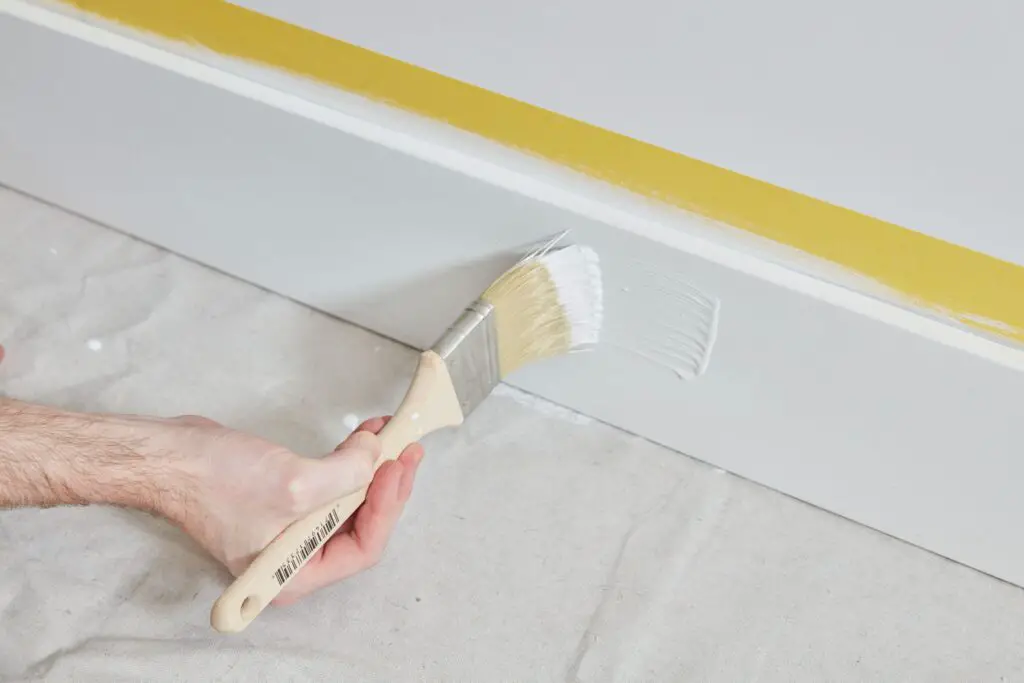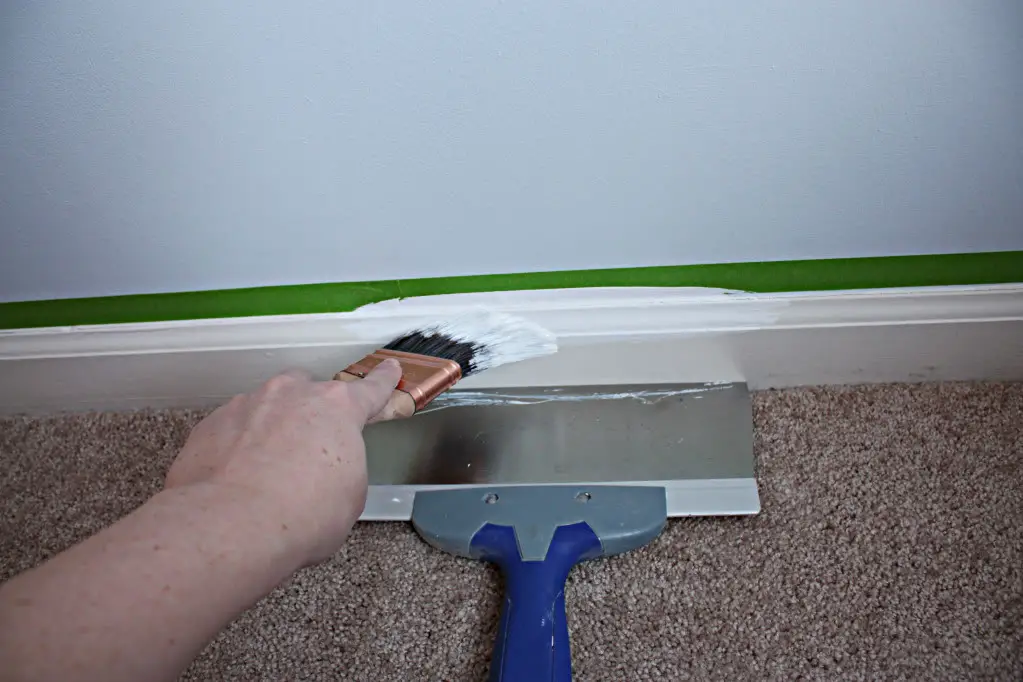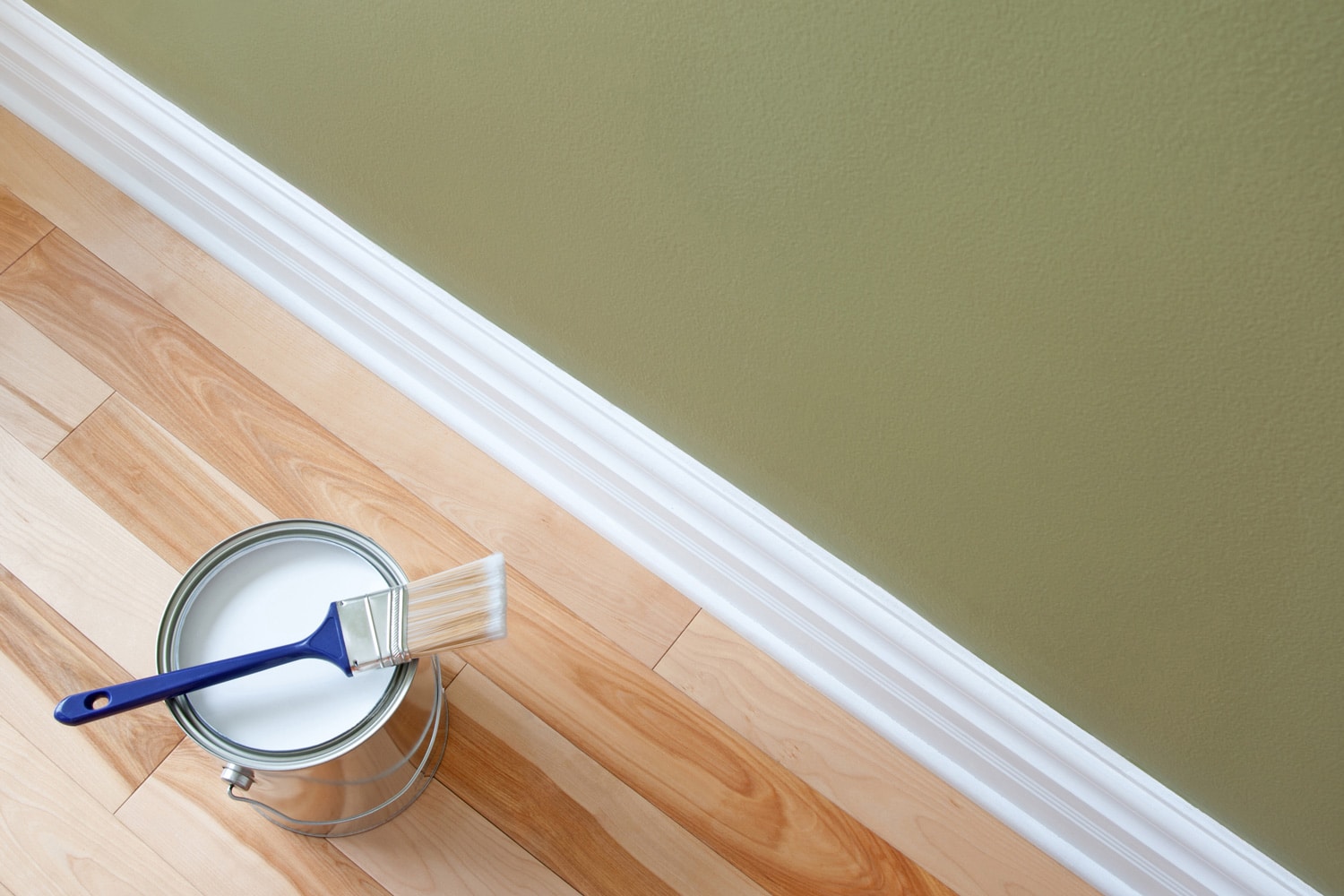How To Repaint Trim And Baseboards
Introduction
How To Repaint Trim And Baseboards: Can be a great way to freshen up the look of a room and give it a polished finish. Over time, these areas can become scuffed, chipped, or discolored, making the entire space appear worn and outdated. However, with the right tools and techniques, repainting trim and baseboards can be a relatively simple and cost-effective DIY project.
It is important to properly prepare the surfaces before beginning the repainting process. This involves removing any existing paint or varnish, filling in any cracks or holes, and sanding the surfaces to create a smooth and even base. This step is crucial for ensuring that the new paint adheres properly and provides a long-lasting finish.
It is essential to choose the right type of paint for the job. Trim and baseboards are often subject to a lot of wear and tear, so it is important to select a paint that is durable and easy to clean. Semi-gloss or high-gloss paints are commonly used for trim and baseboards as they provide a smooth and shiny finish that is resistant to scuffs and stains. It is also important to consider the color of the paint and how it will complement the overall color scheme of the room.
The surfaces are prepared and the paint is chosen, it is time to start painting. It is recommended to use a small brush or a foam roller for trim and baseboards, as these tools allow for more precision and control. It is important to apply thin and even coats of paint, allowing each coat to dry completely before applying the next. This will help to prevent drips and ensure a smooth and professional-looking finish.

Can you paint over painted baseboards?
Baseboards that do not have factory-applied primer or a raw wood surface should always be primed before painting. Previously primed or painted baseboards can also benefit from a primer coat, but this is not always necessary if the cleaned surface is in good condition.
Yes, you can paint over painted baseboards. Painting over painted baseboards is a common practice when you want to update the look of your baseboards or change the color scheme of your room. It is a relatively simple and cost-effective way to give your baseboards a fresh and new appearance without having to replace them entirely.
Prepare the surface before painting over painted baseboards. This includes cleaning baseboards to eliminate dust, grease, and filth. Clean baseboards with a moderate detergent and water solution, then rinse well. After cleaning the baseboards, lightly sand them to prepare them for paint.
Priming for Adhesion: Enhancing Baseboard Paint Application
When selecting the paint for your baseboards, it is important to choose a high-quality paint that is specifically formulated for trim and baseboards. This type of paint is usually more durable and has a higher sheen, which helps to protect the baseboards from wear and tear. You can choose a paint color that complements the overall color scheme of your room or opt for a contrasting color to make the baseboards stand out.
Once you have chosen the paint, you can apply it to the baseboards using a brush or roller. Start by painting the edges and corners of the baseboards, and then fill in the rest of the surface. Apply the paint in thin, even coats to avoid drips or streaks. Allow each coat to dry completely before applying the next one. Depending on the color and coverage you desire, you may need to apply multiple coats of paint.
Do I need to sand before repainting trim?
Prepare the Trim
Scuff-sand the surface of the trim. Start with coarse, 80-grit sandpaper and then move to less-coarse 100- and 120-grit. If the trim is new, use only 120-grit just enough to remove any sheen from the surface. Folded sandpaper or a sanding block can be used for flat surfaces.
When it comes to repainting trim, one common question that arises is whether or not sanding is necessary before applying a new coat of paint. The answer to this question depends on a few factors, including the condition of the existing trim and the type of paint you plan to use. In some cases, sanding may be necessary to ensure a smooth and even surface for the new paint to adhere to. However, there are also situations where sanding may not be required.
If the existing trim is in good condition and the paint is not peeling or chipping, you may be able to skip the sanding step. In this case, you can simply clean the trim thoroughly and apply a new coat of paint directly over the old one. This can save you time and effort, especially if the trim is in relatively good shape.
Addressing Peeling Paint: Essential Sanding for Smooth Surfaces
Consider the paint type you’ll use. With latex or water-based paint, sanding may not be necessary. These paints stick well and can be applied directly on trim without sanding. Sanding is especially important with oil-based paint. Sanding is recommended for oil-based paints to adhere.
Whether or not you need to sand before repainting trim depends on the condition of the existing trim and the type of paint you plan to use. If the trim is in good condition and the paint is not peeling or chipping, you may be able to skip the sanding step.
Do I need to sand my baseboards before painting?
Do I need to sand the baseboards before painting?Yes!Sand the bottom boards first. In this way, you begin with a surface that is perfect.
A lot of people aren’t sure if they need to sand the edges before painting them. This depends on how bad the baseboards are and what you want to achieve with the painting job. It’s not normally necessary to sand baseboards before painting them.
Before painting, sanding the edges makes the surface smooth and flat. It can also get rid of bumps and rough spots in the baseboards. Another way to get rid of peeling or chipped paint or finishes is to sand them. You might not need to sand the edges if they are smooth and in good shape. A small sanding with fine-grit sandpaper might be enough to make the surface rougher so that the paint sticks better.
Sand slowly and with the right tools to keep borders from getting damaged. A sanding block or sandpaper wrapped around a block can help keep things from goinguge and hurting. Before sanding, make sure the edges are completely clean of all dirt, dust, and grease. This makes sure that the paint and cleaning work well.
It’s often a good idea to sand borders before painting them, but not always. Depending on the condition of the baseboards and the goals of the painting job, you may need to sand them. To keep from damaging the baseboards, you should be careful and use the right tools when you sand them.
Can you paint over painted wood trim?
Absolutely! No need to replace wood trim if you like the profile. You can definitely paint it any color you like, as long as you follow the proper technique.
Yes, it is possible to paint over painted wood trim. Whether you want to update the color of your trim or simply refresh its appearance, painting over painted wood trim can be a cost-effective and relatively easy way to achieve the desired result. However, there are a few important factors to consider before embarking on this project.
You need to assess the condition of the existing paint on the wood trim. If the paint is in good condition, meaning it is not peeling, cracking, or chipping, you can proceed with painting over it.
Prepping Wood Trim for Painting: Cleaning and Sanding
Choosing the right type of paint is crucial for a successful outcome. It is recommended to use a high-quality latex or oil-based paint specifically designed for trim. These paints are durable and provide a smooth finish. Additionally, consider the color you want to achieve and select a paint that matches your desired shade.
When painting over painted wood trim, it is important to apply multiple thin coats rather than one thick coat. This helps ensure an even and professional-looking finish. Allow each coat to dry completely before applying the next one. Additionally, consider using a brush or roller specifically designed for trim to achieve precise and smooth application.
Is it better to sand or strip paint?
It is faster, easier, and safer to strip paint than to sand it. Sanding takes longer, can be harsher on the wood, and in the case of some paints, spreads dangerous particles into the air.
You will need several materials and tools. Firstly, you will need a high-quality paint that is suitable for trim and baseboards. It is recommended to choose a paint with a semi-gloss or satin finish for durability and easy cleaning. Additionally, you will need a primer specifically designed for trim and baseboards to ensure proper adhesion and a smooth finish.
In terms of tools, you will need a paintbrush or a small roller for applying the paint. A high-quality brush with synthetic bristles is recommended for a smooth and even application. You will also need painter’s tape to protect adjacent surfaces from paint splatters. A putty knife and wood filler may be necessary to repair any damaged areas before painting. Lastly, you will need sandpaper or a sanding block to smooth the surface and create a good base for the paint.
Overall, the materials and tools needed for repainting trim and baseboards include paint, primer, paintbrush or roller, painter’s tape, putty knife, wood filler, and sandpaper or sanding block.
What steps should be followed to properly prepare trim and baseboards for repainting?
Proper preparation is crucial for achieving a professional-looking finish when repainting trim and baseboards. The first step is to remove any existing paint or finish from the surface. This can be done by sanding the trim and baseboards with sandpaper or using a chemical paint stripper. Once the surface is smooth and free of old paint, it is important to clean it thoroughly to remove any dust, dirt, or grease. A mild detergent solution and a sponge or cloth can be used for this purpose.
Fill trim and baseboard holes, cracks, and defects with wood filler after cleaning. For a smooth finish, sand the dry filler. A trim and baseboard primer is needed next. Paint will apply better and finish more evenly with primer. We recommend applying two coats of primer and letting each dry before applying the next.
Finally, before painting, it is important to protect adjacent surfaces by applying painter’s tape. This will prevent any accidental paint splatters or smudges.
What steps should be followed to properly prepare trim and baseboards for repainting?
Preparing trim and baseboards before repainting is crucial to ensure a smooth and long-lasting finish. Here are the steps that should be followed:
Clean the surfaces: Start by removing any dust, dirt, or grime from the trim and baseboards. Use a mild detergent and water solution to clean the surfaces thoroughly. Rinse with clean water and allow them to dry completely.
Remove old paint or finish: If there is any peeling or chipping paint, it needs to be removed. Use a scraper or sandpaper to gently scrape off the old paint. Be careful not to damage the wood underneath. If there is a previous finish, it may need to be stripped using a chemical stripper.
Fill in gaps and holes: Inspect the trim and baseboards for any gaps, cracks, or nail holes. Use a wood filler or putty to fill in these imperfections. Smooth out the filler with a putty knife and let it dry completely. Sand the filled areas until they are smooth and level with the rest of the surface.
How should the trim and baseboards be painted to achieve a smooth and even finish?
To achieve a smooth and even finish when painting trim and baseboards, it is important to follow a few key steps. First, make sure to thoroughly clean the surfaces to be painted. Use a mild detergent and water solution to remove any dirt, dust, or grease. Once the surfaces are clean, sand them lightly to create a smooth and even surface for the paint to adhere to. This will also help to remove any existing paint or varnish that may be peeling or chipping.
After sanding, it is important to prime the trim and baseboards before applying the final coat of paint. Primer helps to create a smooth and even surface for the paint to adhere to, and it also helps to prevent any stains or discoloration from bleeding through the paint. Apply the primer evenly using a brush or roller, and allow it to dry completely before moving on to the next step.
Are there any specific techniques or tips for painting intricate or detailed trim and baseboards?
When it comes to painting intricate or detailed trim and baseboards, there are a few techniques and tips that can help you achieve a professional-looking finish. Firstly, it is important to choose the right brush for the job. A small, angled brush with fine bristles will allow for more precision and control when painting intricate details.
Another important tip is to use a primer specifically designed for trim and baseboards. This will help the paint adhere better and provide a smoother finish. Before painting, make sure to clean the trim and baseboards thoroughly to remove any dirt or grease. Sanding the surface lightly can also help create a smoother surface for the paint to adhere to.
When painting intricate details, it is best to start with the smallest areas first and work your way outwards. Take your time and use steady, controlled strokes to avoid any drips or smudges. If you make a mistake, don’t panic. Simply wait for the paint to dry and then carefully touch up the area with a small brush.
To ensure the longevity and durability of the newly painted trim and baseboards, consider applying a clear topcoat or sealant. This will provide an extra layer of protection against wear and tear, making your paint job last longer.
How can one ensure the longevity and durability of the newly painted trim and baseboards?
It is very important to use a good primer after the surfaces are clean and smooth before painting. The primer helps to seal the surfaces, stop spots from seeing through, and make it easier for the paint to stick. It is suggested that you use a primer that is made especially for trim and borders because it will last longer and protect better.
It is very important to use good paint when painting the trim and borders. Choose a paint that is made to be used on trim and stairs. It will last longer and be less likely to chip or peel. Use a brush or roller to spread the paint out in thin, even layers. Before putting on the next coat, make sure the last one is completely dry.
It is also important to take good care of the newly painted stairs and trim to make sure they last a long time. Do not use strong cleaners or rough materials on the paint; they can damage it. Dust the surfaces often and clean them with a soft cloth or brush.

Conclusion
Repainting trim and baseboards is a relatively simple and cost-effective way to refresh the look of a room. By following the steps outlined in this guide, homeowners can achieve professional-looking results without the need for hiring a professional painter.
First and foremost, it is important to properly prepare the surfaces before painting. This includes cleaning the trim and baseboards, sanding any rough areas, and filling in any holes or cracks. Taking the time to properly prepare the surfaces will ensure that the paint adheres well and provides a smooth and even finish.
Choosing the right paint and tools is crucial for a successful painting project. Additionally, using the right tools such as a high-quality brush or roller will make the painting process easier and more efficient.
Taking the time to apply multiple thin coats of paint rather than one thick coat will result in a more professional-looking finish. This allows the paint to dry evenly and minimizes the risk of drips or streaks. Additionally, allowing each coat to dry completely before applying the next will ensure a smooth and flawless finish.
Repainting trim and baseboards is a DIY project that can easily be accomplished by homeowners. By following the steps outlined in this guide and taking the time to properly prepare the surfaces, choose the right paint and tools, and apply multiple thin coats, homeowners can achieve professional-looking results and refresh the look of their rooms.








